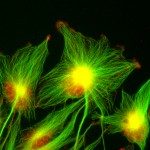Lien vers Pubmed [PMID] – 21388224
ACS Nano 2011 Apr;5(4):2587-92
Nanotechnology as well as advanced microscopy can play a fundamental role in understanding biological mechanisms. Here we present a study that combines a new type of nanomaterial with a new type of microscopy and highlights the potential for gathering novel information about cell membrane penetration and cytosol local viscosity. On the material side, we used gold nanoparticles that have an ordered stripe-like arrangement of domains. These “striped” nanoparticles are able to penetrate cell membranes directly without porating them. On the microscopy side, we used photothermal heterodyne imaging which allows detection of individual nanometer-sized gold particles in complex media. We showed that we can probe cytosolic presence as well as dynamics of these nanoparticles even at very low concentrations. We used the fluctuations of the photothermal signal from particles diffusing in the detection volume to estimate local cytosol viscosity which is about 20 times larger than that of water. This work opens new perspectives for mapping local diffusion properties of nano-objects inside living cells.
